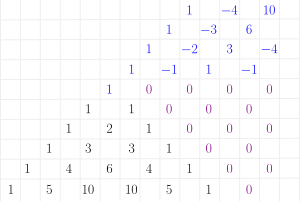Introduction Binomial expansion
(
a
+
b
)
0
=
1
(
a
+
b
)
1
=
a
+
b
(
a
+
b
)
2
=
a
2
+
2
a
b
+
b
2
(
a
+
b
)
3
=
(
a
+
b
)
(
a
+
b
)
2
=
(
a
+
b
)
(
a
2
+
2
a
b
+
b
2
)
=
a
3
+
2
a
2
b
+
a
b
2
+
b
a
2
+
2
a
b
2
+
b
3
=
a
3
+
3
a
2
b
+
3
a
b
2
+
b
3
(
a
+
b
)
4
=
⋯
{\displaystyle {\begin{aligned}(a+b)^{0}&=1\\(a+b)^{1}&=a+b\\(a+b)^{2}&=a^{2}+2ab+b^{2}\\(a+b)^{3}&=(a+b)(a+b)^{2}=(a+b)(a^{2}+2ab+b^{2})\\&=a^{3}+2a^{2}b+ab^{2}+ba^{2}+2ab^{2}+b^{3}\\&=a^{3}+3a^{2}b+3ab^{2}+b^{3}\\(a+b)^{4}&=\cdots \end{aligned}}}
Pascal's triangle Pascal's Triangle The coefficients of binomial expansion can be easily seen from the Pascal triangle. The number is a sum of the two numbers above it.
Pascal's triangle: Negative right This can be extended to negative numbers easily.
Pascal triangle extended to negative values Now, instead of expanding
(
a
+
b
)
n
{\displaystyle (a+b)^{n}}
(
1
+
x
)
n
{\displaystyle (1+x)^{n}}
n
{\displaystyle n}
(
1
+
x
)
−
1
=
1
−
x
+
x
2
−
x
3
+
⋯
(
1
+
x
)
−
2
=
1
−
2
x
+
3
x
2
−
4
x
3
+
⋯
(
1
+
x
)
−
3
=
1
−
3
x
+
6
x
2
−
⋯
{\displaystyle {\begin{aligned}(1+x)^{-1}&=1-x+x^{2}-x^{3}+\cdots \\(1+x)^{-2}&=1-2x+3x^{2}-4x^{3}+\cdots \\(1+x)^{-3}&=1-3x+6x^{2}-\cdots \end{aligned}}}
And by Taylor series (expansion at
x
=
−
1
{\displaystyle x=-1}
Pascal's triangle: Negative left The triangle can be extended to the left also, but it is symmetric to the earlier.
Pascal's triangle: half-integers Newton: Find the area of the curve
y
=
1
−
x
2
=
(
1
−
x
2
)
1
/
2
{\displaystyle y={\sqrt {1-x^{2}}}=(1-x^{2})^{1/2}}
A
=
π
/
4
{\displaystyle A={\frac {\pi }{/}}4}
y
0
=
(
1
−
x
2
)
0
/
2
=
(
1
−
x
2
)
0
=
1
y
1
=
(
1
−
x
2
)
1
/
2
y
2
=
(
1
−
x
2
)
2
/
2
=
1
−
x
2
y
3
=
(
1
−
x
2
)
3
/
2
y
4
=
(
1
−
x
2
)
4
/
2
=
(
1
−
x
2
)
2
=
1
−
2
x
+
x
4
y
5
=
(
1
−
x
2
)
5
/
2
y
6
=
(
1
−
x
2
)
6
/
2
=
(
1
−
x
2
)
3
=
1
−
3
x
2
+
3
x
4
−
x
6
{\displaystyle {\begin{aligned}y_{0}&=(1-x^{2})^{0/2}=(1-x^{2})^{0}=1\\y_{1}&=(1-x^{2})^{1/2}\\y_{2}&=(1-x^{2})^{2/2}=1-x^{2}\\y_{3}&=(1-x^{2})^{3/2}\\y_{4}&=(1-x^{2})^{4/2}=(1-x^{2})^{2}=1-2x+x^{4}\\y_{5}&=(1-x^{2})^{5/2}\\y_{6}&=(1-x^{2})^{6/2}=(1-x^{2})^{3}=1-3x^{2}+3x^{4}-x^{6}\end{aligned}}}










